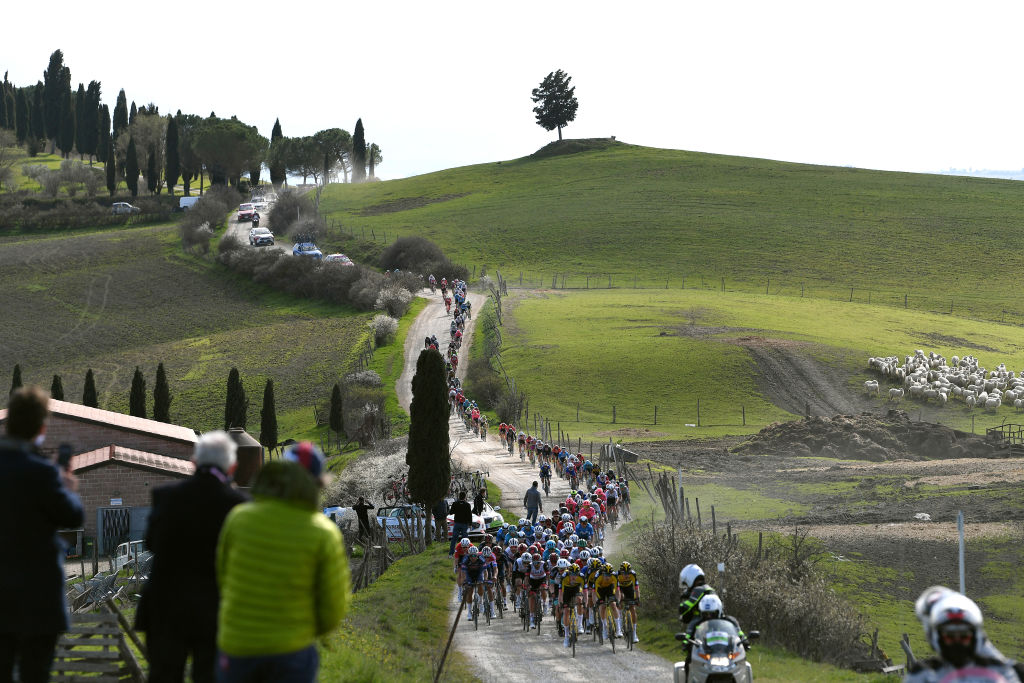Strade Bianche peloton dial in equipment and strategy during final recon rides
Thursday and Friday reconnaissance rides could prove key to victory on Saturday

The teams targeting Strade Bianche and Strade Bianche Women have carried out their vital last reconnaissance rides of the Tuscan gravel roads before Saturday's races, getting a final feel for the unique farm track and climbs, and mentally preparing for a day of suffering and spectacular racing.
Jumbo-Visma, Trek-Segafredo, Movistar, Canyon-Sram, Ineos Grenadiers, Lotto Soudal, AG2R Citroën and many others rode the key dirt sections of the race route on Thursday, focussing on studying the long gravel sections that begin after Montalcino, with around 100 kilometres to race.
Some also rode the final short but steep sections of Montaperti, Colle Pinzuto and Le Tolfe, and even rode into central Siena via the Via Santa Caterina climb and into the Piazza del Campo to see where the finish line will be on Saturday, with Lotto Soudal's Victor Campenaerts 'celebrating' as he finished his ride.
All the riders headed out for a final easy ride on Friday after some overnight rain, to get a final taste of the conditions of the gravel roads and finalise tyre pressures and equipment choices.
Most teams arrived in Tuscany on Wednesday, giving them plenty of time to prepare for Saturday's races. In just 15 years, Strade Bianche has grown to become a major goal for almost every team in the men's and women's peloton.
A rider survey carried by French newspaper L’Equipe revealed that 53 per cent of riders believe Strade Bianche deserves to be designated as the sport's sixth monument Classic alongside Milan-San Remo, the Tour of Flanders, Paris- Roubaix, Liège-Bastogne-Liège and Il Lombardia.
In the absence of recent winners Mathieu van der Poel and Wout van Aert, as well as Tom Pidcock, who has been struck by a stomach bug, this year's Strade Bianche is wide open with a host of riders perhaps able to beat big-name contenders Tadej Pogačar and Julian Alaphilippe.
The latest race content, interviews, features, reviews and expert buying guides, direct to your inbox!
'Riding on the gravel is a bit like driving on ice'
Bike skills play a huge role at Strade Bianche, helping to avoid crashes and punctures, to take the best and fastest lines on the gravel descents and corners, and to hold position when the peloton is often lined out across several hundred metres.
QuickStep-AlphaVinyl will use 33mm Roval Alpinist tubeless wheels, according to Italian website BiciPro, with all teams opting for tyre pressures of around 5-5.2 bar for the front wheel and 5.5-5.7 bar for the rear wheel, based on rider weight. Exact tyre pressures are a carefully guarded secret in the hope of finding the sweet spot between adherence and speed.
Riders will opt for slightly different chainring sizes, while rear gearing will go as low as a 32-toothed sprocket to help on the steepest section of gravel and to keep the most used gears in the middle of the block.
"Riding on the gravel is a bit like driving on ice. You can't be afraid to let the bike slide a little. You can't be aggressive with you steering and you need a it of luck," Alberto Bettiol explained to La Gazzetta dello Sport. The Tuscan is frustrated that a recent COVID-19 infection means he won't be able to ride his local race and has left him chasing his form for the spring Classics.
Greg Van Avermaet explored the last five gravel sections of Strade Bianche with his AG2R Citroën teammates on Thursday, and he knows the thrill and risk of riding Strade Bianche after riding the race twelve times, placing second in 2015 and 2017.
"I love racing here, it was one of the most beautiful reconnaissance of the year and the weather conditions were not too bad," Van Avermaet told the Belga news agency.
"It's helpful to remember what the gravel roads look like. They look very clean this year, at the moment it looks like it'll be one of the better editions. There is not too much gravel, and it is nicely compacted."
Alpecin-Fenix rider Floris De Tier has ridden Strade Bianche five times and finished 13th in 2018 when cold rain turned Strade Bianche into a battle of survival.
"In 2018, I discovered that when it is wet, it is a lot less dangerous than when it is bone dry. The surface is the same, but there is no dust layer on it. And it's that layer that makes it dangerous and makes you slide the most," De Tier told Het Nieuwsblad.
"The weather is good now. They expect a little rain on Friday, but I don't know if that will change the course much by Saturday. In some sections the gravel is really loose, and if the gravel is a bit thicker, it is really dangerous in the corners and you have to be careful not to fall.
"Taking gravel bends is just pure daring and riding skills. You have guys who are so agile that they dare to go into corners without braking, and then there are others who squeeze the brakes very quickly out of caution when it's not necessary at all. So you have to take risks, but you also just have to have the technique to be able to take good lines. That can really make a difference in the Strade Bianche."
A dry but not dusty race in 2022
Since the wet and muddy 2018 edition, the Strade Bianche gravel roads – 'sterrate' as they are called locally – have been dry and dusty. The rescheduled 2020 edition was held in the heat of August, while this year, a change in weather will see an easterly wind bring in cold air and move away the clouds that caused Friday's rain showers.
Local weather forecasts are expecting temperatures as low as 0°C for the start of the women's race at 9.00am, but with temperature of around 10°C for the afternoon race finishes.
Cross winds could play a significant part in both the men's and women's race. The easterly winds could blow at around 20kph and there could be a cross-head wind in the final 100 kilometres of the race.
The wind will be a major factor on the long exposed sectors of gravel roads across the treeless Crete Senese hills, including the lengthy San Martino in Grania gravel sector and the 11.5-kilometre Monte Sante Marie sector.
The winds could deter attacks or spark an even earlier selection if a team decides to go on the attack.
As well as the spectacular gravel roads and rolling hills of Tuscany, the uncertainty and the aggressive racing is another reason why Strade Bianche has earned near monument status in just 15 years.
Such a hard race, but what a magnificent landscape @StradeBianche 😍 #RideDifferently pic.twitter.com/e0R8UVj2ABMarch 4, 2022
Who else loves seeing our riders on Tuscany’s charming white roads? 😃Photo: @BeelWout pic.twitter.com/uCT8QBrFaxMarch 3, 2022
Collectief genieten van de Piazza del Campo, de heren en dames van Jumbo-Visma pic.twitter.com/ERPkbymYzfMarch 3, 2022

Stephen is one of the most experienced member of the Cyclingnews team, having reported on professional cycling since 1994. He has been Head of News at Cyclingnews since 2022, before which he held the position of European editor since 2012 and previously worked for Reuters, Shift Active Media, and CyclingWeekly, among other publications.